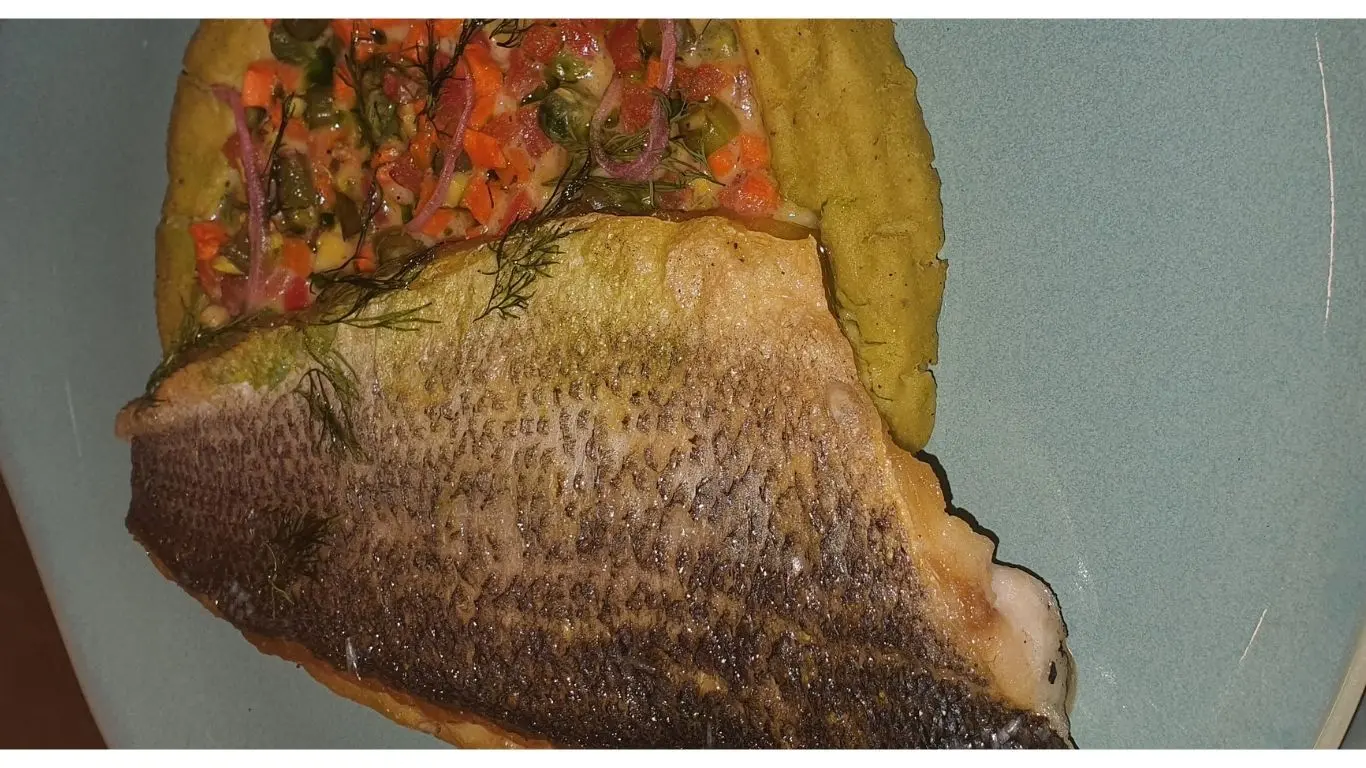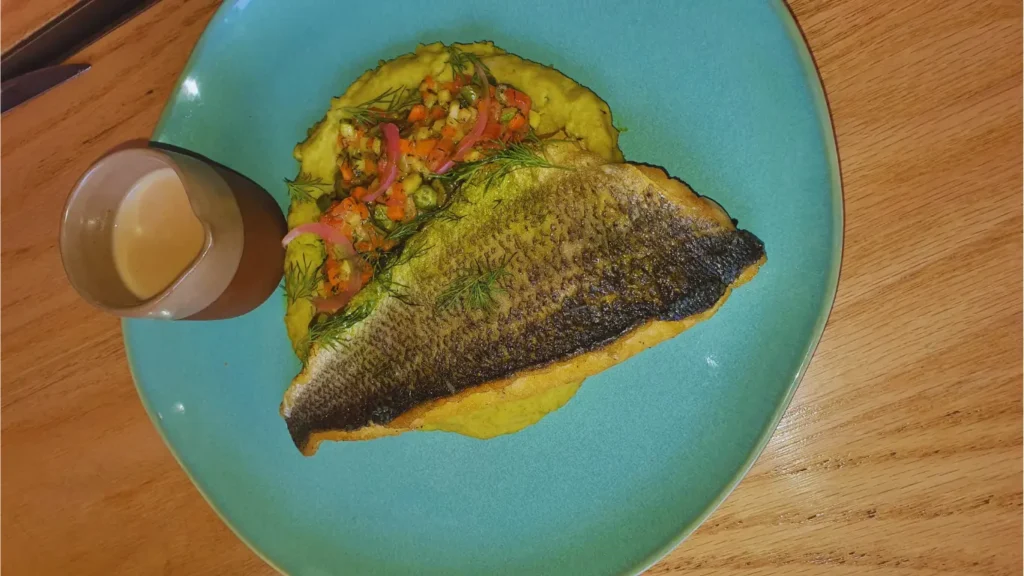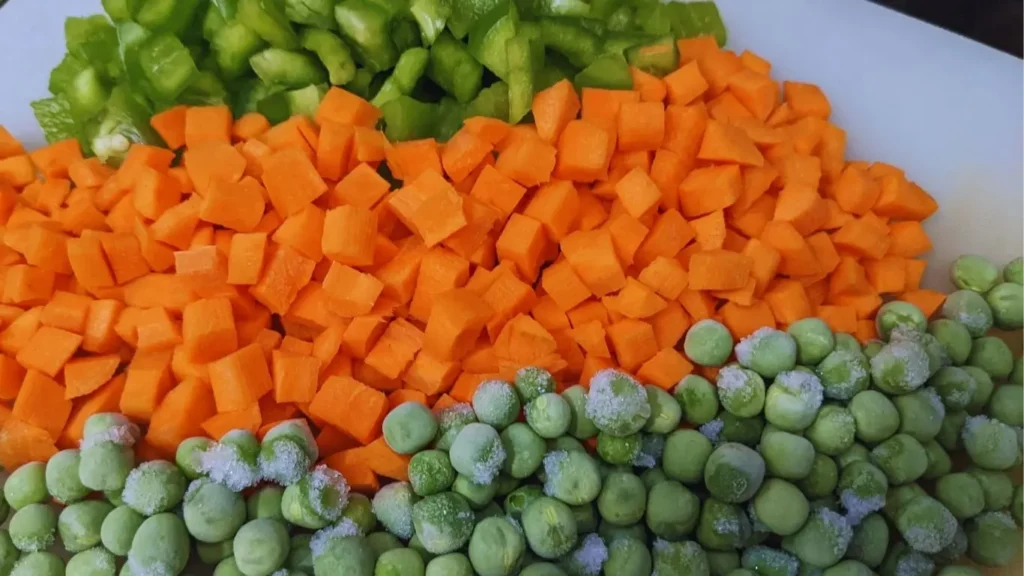Sea Bass with Fava Bean Purée & Lemon

Table of Contents
Introduction
Are you looking for a restaurant-quality seafood dish to wow your guests? This Sea Bass with Fava Bean Purée, Miso Foam, and Lemon Velouté is the perfect choice! Think silky purée, airy foam, tender sea bass, and a citrusy sauce – all coming together on one elegant plate.
In this article, you’ll get the full step-by-step guide to mastering this gourmet recipe at home. Whether you’re cooking for a dinner party or just want to try something new, this dish is both doable and impressive.

1. Choosing the Right Sea Bass
The heart of this dish is, of course, the sea bass. For the best results:
- Choose fresh fillets with firm flesh and a clean, ocean-like smell.
- Wild-caught sea bass will provide richer flavor, but sustainably farmed options are also good.
Tip: If sea bass isn’t available, you can substitute with cod, halibut, or snapper.
2. The Secret Behind a Smooth Fava Bean Purée
This purée acts as the creamy base for your dish.
Ingredients:
- Fava beans (400-600g)
- Butter (35g)
- Salt and pepper
Preparation Steps:
- Blanch the fava beans in boiling water for a few minutes.
- Peel off their outer skins for a smoother texture.
- Blend with butter until velvety.
- Season to taste.
Why this works: The butter adds richness while the beans give a subtle earthiness.
3. Understanding Miso Foam
Miso foam gives this dish a modern, gourmet touch. It’s light, airy, and full of umami flavor.
Ingredients:
- Fish stock (300g)
- Cream (20g)
- Lecithin powder (for foaming)
How to Make It:
- Warm the fish stock and cream.
- Blend with lecithin powder.
- Use an immersion blender to create the foam right before serving.
Analogy: Think of this foam as the “flavor cloud” that wraps around each bite.
4. Crafting the Perfect Lemon Velouté
This Lemon Velouté adds brightness and balances the rich flavors of the dish.
Ingredients:
- Fish stock (2L)
- Lemon zest and juice (from 3 lemons)
- Fresh cream (500ml)
- Salt and pepper
Cooking Steps:
- Reduce the fish stock by half.
- Add lemon zest and juice.
- Stir in the cream.
- Season with salt and pepper.
Result: A silky, citrusy sauce that cuts through the richness beautifully.
5. Prepping Your Vegetables for Garnish
The veggie garnish adds color and texture.
Suggested Vegetables:

- Courgette (zucchini)
- Carrot
- Haricot verts (green beans)
- Peas
- Tomato
Preparation:
- Cut all vegetables into thin julienne strips.
- Lightly sauté in olive oil with a splash of lemon juice.
- Keep them vibrant and slightly crunchy.
6. Cooking Techniques for Perfect Sea Bass
To get that restaurant-style crisp skin and tender interior:
- Season the fillet with salt and pepper.
- Heat olive oil and butter in a pan.
- Sear skin-side down until golden.
- Flip and finish cooking until the fish is flaky but moist.
Pro Tip: Always start cooking with the skin side down for a crispy finish.
7. Assembling Your Dish Like a Pro
Now comes the fun part: putting everything together.
- First layer: Spread a generous spoon of fava bean purée on the plate.
- Next: Place your cooked sea bass on top.
- Add the veg: Neatly arrange your sautéed vegetables around the fish.
- Spoon the foam: Gently place the miso foam over the veggies.
- Finish with velouté: Pour the lemon velouté around the main elements.
8. Plating Tips for Restaurant-Style Presentation
Here are simple tricks to make your dish Instagram-worthy:
- Use a ring mold for the purée for clean lines.
- Layer textures and colors for contrast.
- Wipe the plate edges before serving.
Visualize: Imagine a modern art painting… but edible
9. Flavor Pairing Suggestions
This dish balances many flavor profiles:
- Umami from the miso
- Citrus brightness from the velouté
- Earthiness from the fava purée
- Sweetness and crunch from the veggies
- Delicate ocean flavors from the sea bass
Optional Add-ons:
- Microgreens
- Lemon zest curls
- Edible flowers for color
10. Wine Pairing Ideas
For wine lovers:
- White Wine: Sauvignon Blanc, Chardonnay, or Albariño.
- Sparkling: A light Brut Champagne works great for special occasions.
- Non-Alcoholic: A citrus-infused sparkling water or elderflower tonic.
11. Nutritional Information
Here’s an approximate breakdown (per serving):
- Calories: 500-600 kcal
- Protein: 35g
- Fat: 30g
- Carbohydrates: 20g
- Fiber: 6g
Note: These values may vary based on portion size and ingredients used.
12. Recipe Variations You Can Try
Want to experiment?
- Swap the Fish: Try salmon, cod, or halibut.
- Alternate Purée: Replace fava beans with peas or cauliflower.
- Foam Flavor Twist: Infuse the foam with ginger or garlic.
- Sauce Options: Try an orange reduction instead of lemon.
13. Storage and Reheating Tips
If you have leftovers:
- Sea Bass: Store in an airtight container. Reheat gently in the oven.
- Purée & Velouté: Keep in the fridge for up to 2 days.
- Foam: Best made fresh, doesn’t store well.
Freezing Tip: Only the purée freezes well.
14. Common Mistakes to Avoid
- Overcooking the fish: It dries out quickly.
- Skipping the foam step: It adds that gourmet touch!
- Not reducing the velouté enough: You want a thick, flavorful sauce.
- Using too much lemon: Balance is key.
15. Conclusion and Final Thoughts
This Sea Bass with Fava Bean Purée, Miso Foam & Lemon Velouté isn’t just a dish—it’s an experience. It’s where elegance meets flavor, and every bite tells a story. Perfect for special dinners, date nights, or when you simply want to impress.
So why not give it a try this weekend? Trust me, your guests will be asking for the recipe!
FAQs
1. Can I prepare parts of this dish in advance?
Yes! You can make the fava bean purée and lemon velouté a day before. Just reheat gently before serving.
2. What can I use instead of sea bass?
Cod, halibut, or snapper are great alternatives.
3. Is there a vegetarian version of this dish?
You can replace the fish with grilled tofu or roasted vegetables and swap the fish stock with vegetable broth.
4. How do I make the foam without lecithin?
You can use a handheld milk frother with a bit of cream and broth for a lighter foam.5. What side dishes go well with this recipe?
Light salads, roasted baby potatoes, or a simple quinoa salad complement this dish beautifully.
